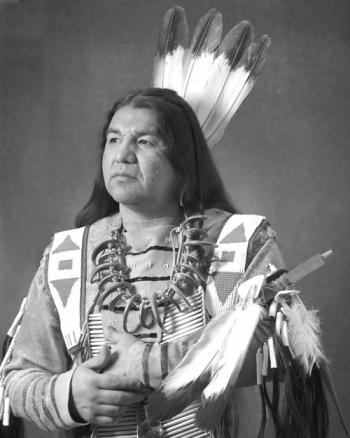Image Caption
By Dianne Meili
Windspeaker.com Archives
Outside the community centre in an artsy tourist town near Calgary, a white horse stands easily, indifferent to the burden laid across her back: a magnificent spotted loon skin spread upon a tanned animal hide.
The horse takes no heed of the hundreds of people milling about her, speaking animatedly, except to lower her head when a child breaks from its parents to come and pet her nose.
The people are shifting from foot to foot, not nearly as patient as the horse. They want to enter the hall to begin this celebration of artist Dr. Dale Auger's life, a man who embodied the spirit of the loon and who admired its ability to live in many worlds under the water, floating on its surface, or winging its way across the sky.
Finally, a word is given and the crowd ambles through the doors of the hall. They are greeted by a room encircled with large and small canvases splashed with intense hues glowing in the showroom: turquoise, lilac, yellow ochre and red.
"He brought colour into a black and white world," said Sekwan Auger, in homage to her father, who passed away in a Calgary hospital on Sept. 23, 2008 in his 50th year.
Her family has asked that owners of his paintings bring them to the day's memorial ceremony; in total they constitute the largest showing of his work ever assembled.
It's overwhelming to take in all the images: a blue horse with white spots under the bent willows of a sweatlodge; a raven-haired woman picks wild flowers under a fuchsia sky; and yellow-headed songbirds mysteriously jettison from between the lips of a fierce, top-knotted warrior.
Many come forward to share memories of Auger; the stories as varied and colourful as the paintings themselves.
Close friend Stan Carscallen laughs about the time he was drafted to be a death-defying warrior riding a horse in one of the outdoor dinner theatre productions Auger produced for several years.
"At the last minute, the original actor didn't show up so Dale looked at me and said 'it's gonna have to be either me or you that takes his place, and I need to be here producing the show.' So, I didn't want to ride that wild horse, but how can you say no to Dale?" Carscallen asks the audience.
B.C. singer and songwriter Art Napoleon, who sang and played both the drum and guitar at the gathering, admits he was a "closet singer" before Auger urged him to "get out there and go for it in the music world."
He tells the audience how much fun he had whenever he spent time with Dale and how the artist "brought out the mischievous side of me."
Two-time world champion hoop dancer Dallas Arcand, from Alexander First Nation west of Edmonton, performs for the crowd as a "gift" to the man who encouraged him to practice and excel in his music and dancing.
Auger, over and above his many other talents, had a gift for pushing people out of their comfort zones and nowhere was he more in his element than at a 2005 workshop held by the Sun and Moon Visionaries Aboriginal Artisans Society in Edmonton.
Standing before a group of 20 painters, from beginner to professional, Auger horrified his audience by wiping a crumpled paper towel dipped in black paint across an immaculate white canvas.
Standing back, he identified shapes in the loose, random strokes and began dipping his brushes into various colours, eventually ending up with an animated scene of two people sitting on the ground, talking, their feathered hair ties blowing in the wind.
"For many years I was into realism and I would paint a still life down to the exact detail," Auger told his students. "But now, I just paint what the spirit world has to show me. I never paint from a photograph or picture. Try it! Paint as though you're not quite sure what will emerge on your canvas."
Auger often told audiences how proud he was to be a Sakaw Cree man and have access to the symbols and stories of his ancestors, given to him in teachings from his Elders and through his dreams.
"He loved passing on knowledge and sharing the ways of his people with others," Carscallen tells the audience. "And he'd get excited about it. If he was doing something that portrayed some aspect of culture or spirituality or if you were, he'd get that look in his eyes and he'd say 'that's powerful!' I can still hear him saying it."
Auger especially enjoyed sharing the story of his life from his teen-age years of driving around the back roads of northern Alberta with friends near High Prairie, to his venture into the halls of learning at the University of Calgary.
He credited his mother, Rose Auger, who passed away two years before him, for giving him the drive to accomplish many of his greater undertakings.
While only a child, she would often leave him, much to his chagrin, with Elders and it was only when he got older that he understood she wanted him to be taught in the old way.
"And after learning about the ways of my own people, my mother urged me to learn about the Whiteman's ways. I went back to school after having only a Grade 6 education," Auger is quoted as saying in a 2005 interview produced for the Aboriginal Peoples Television Network.
In 1999, Auger graduated with a doctoral degree in education and was in demand for his visual work, motivational lectures, workshops and keynote addresses.
His illustrated children's book ”Mkakwa Talks to the Loon” won the Aboriginal Children's Book of the Year award in 2006 and the 2007 R. Ross Annett Award for Children's Literature.

